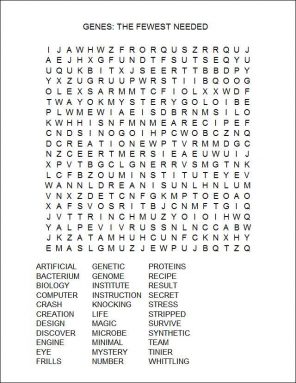Genes: How few needed for life?
People need more than 20,000, but one bacterium was rebuilt — and lived — with a mere 473
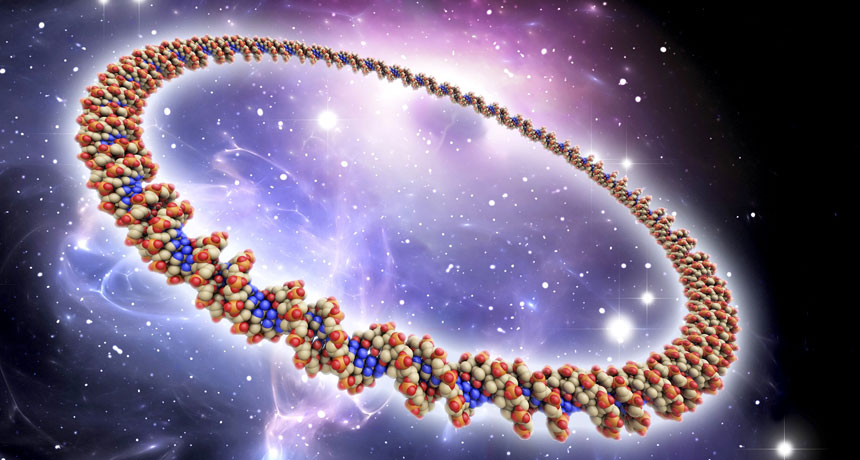
The genetic material in bacteria, including the species used in the new research, typically has a ring-shaped structure (as shown in this artists’ illustration against a space-age background). Scientists have now removed all non-essential elements from one bacterium’s DNA to establish what appears to be the minimum needed to live on their own.
Pasieka / Science Source
What are the fewest genes needed to sustain life? To test that, scientists started with a microbe having one of the smallest known genomes — or entire sets of genetic instructions. Then scientists figured out the magic minimum for this microbe, which was 473 genes. By whittling down the genes to this number, scientists learned a lot about biology. But there is still much to discover. Researchers still aren’t sure exactly what almost a third of its genes do.
The new microbe is a stripped-down version of Mycoplasma mycoides (MY-ko-PLAZ-ma My-KOY-dees). This bacterium normally has 901 genes. That’s really not very many. Quite a few other bacteria, such as E. coli, may have 4,000 to 5,000 genes. People have more than 22,000 genes, although we don’t need all of them to live and be healthy.
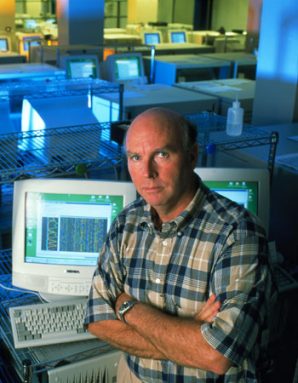
More recently, the researchers started by stripping the M. mycoides genome down to its essentials. Then they transplanted them into the M. capricolum shell. The result was a minimal bacterium that they now call syn3.0.
The researchers described their results March 25 in Science.
Learning from minimal life
Researchers hope syn3.0’s simple genome will teach them more about the basics of biology. Minimal life-forms such as this one could also be a starting point for building custom microbes in the future. These microbes might make certain drugs or chemicals that people need or prize.
J. Craig Venter is the geneticist who founded the nonprofit institute bearing his name. He worked with a team of researchers there led by Clyde Hutchison III and Daniel Gibson. At first, they wanted to design an organism with a core set of about 300 genes. The researchers thought these would be enough for a microbe to survive on its own. Computers predicted this would work. But when the researchers tried to bring their computer creations to life, “every one of our designs failed,” Venter said in a phone conference with reporters.
Why didn’t the microbes live? The researchers had left out some genes because they didn’t know those genes were important.
In fact, scientists don’t know what many genes do. Here, the scientists thought they already knew the essential ones for survival. They were wrong. Almost one-third of the genes in the minimal genome are secret ingredients that do something important, even though scientists don’t know what that something is. Without these genes, the bacteria died. When the researchers mixed those genes back into their recipe, the bacteria sprung to life.
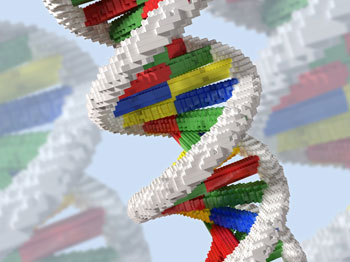
That leaves 149 genes in syn3.0 that do jobs researchers don’t completely understand. Scientists can predict what 70 of these genes likely do. But what the remaining 79 mystery ingredients do is entirely unknown.
“I think we’re showing how complex life is in even the simplest of organisms,” Venter says. The results show that researchers still don’t fully understand the basics of life. “These findings are very humbling,” Venter concludes.
Pamela Silver works at Harvard Medical School in Boston, Mass. As a synthetic biologist, she designs and creates new types of organisms from genes. Silver says that lack of knowledge is “frustrating after so many years of molecular biology.” But, she adds, the new stripped-down microbe may help science learn what those mystery genes do.
Other researchers have tried to make minimal genomes by stripping away one gene at a time. Not Venter’s group. His team built its new microbe from the ground up. They made pieces of DNA from scratch, then combined them into a new genome.
Drew Endy is a synthetic biologist at Stanford University. He is one of several scientists who like the made-from-scratch approach. “Only when you try to build something do you find out what’s truly required. Too often in biology we end up with only data, a computer model, or a just-so story. When you actually try to build something, you can’t hide from your ignorance,” Endy said in an e-mail. “What you build either works or it doesn’t.”
And, at first, this bare-bones genome didn’t work. The problem was that the researchers had compiled a list of genes that they thought they could just leave out. Such genes are known as nonessential. But not all of those genes proved nonessential after all. Some genes did the same job as another gene. Researchers could remove one such gene, but never both at the same time. It’s like a twin-engine jet, Gibson says. Knocking out one engine will keep the plane airborne, but disabling both engines will lead to a crash.
How low can you go?
The genome of syn3.0 is far smaller than those of any natural free-living bacterium. But it’s possible that there are life-forms with even smaller starting genomes. For example, other researchers think it’s possible that there could be some cell hosting just a single gene inside a membrane. It sole job would likely be to copy RNA, says George Church. He’s a geneticist at Harvard University.
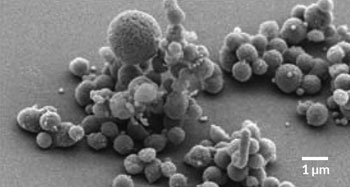
Gibson and Venter agree that they have created a minimal genome, but not necessarily the most minimal genome. Syn3.0 is streamlined, but still has a few frills. The team kept several “quasi-essential” genes that may not be strictly necessary. Still, these genes let the bacteria grow fast enough to be useful in the lab. It is possible that future minimal life-forms might host even tinier genomes.
Power Words
(for more about Power Words, click here)
bacterium (plural bacteria) A single-celled organism. These dwell nearly everywhere on Earth, from the bottom of the sea to inside animals.
cell membrane Separates the inside of a cell from the outside of it. Some particles are permitted to pass through the membrane.
computer model A program that runs on a computer that creates a model, or simulation, of a real-world feature, phenomenon or event.
DNA (short for deoxyribonucleic acid) A long, double-stranded and spiral-shaped molecule inside most living cells that carries genetic instructions. It is built on a backbone of phosphorus, oxygen, and carbon atoms.In all living things, from plants and animals to microbes, these instructions tell cells which molecules to make.
E. coli (short for Escherichia coli) A bacterium that researchers often use to study genetics. Some types of this microbe cause disease, but many other forms of it do not.
gene (adj. genetic) A segment of DNA that codes, or holds instructions, for producing a protein. Offspring inherit genes from their parents. Genes influence how an organism looks and behaves.
genetic Having to do with chromosomes, DNA and the genes contained within DNA. The field of science dealing with these biological instructions is known as genetics. People who work in this field are geneticists.
genome The complete set of genes or genetic material in a cell or an organism. The study of this genetic inheritance housed within cells is known as genomics.
metabolism The set of life-sustaining chemical reactions that take place inside cells and bigger structures, such as organs. These reactions enable organisms to grow, reproduce, move and otherwise respond to their environments.
microbe Short for microorganism. A living thing that is too small to see with the unaided eye, including bacteria, some fungi and many other organisms such as amoebas. Most consist of a single cell.
proteins Compounds made from one or more long chains of amino acids. Proteins are an essential part of all living organisms. They form the basis of living cells, muscle and tissues; they also do the work inside of cells. The hemoglobin in blood and the antibodies that attempt to fight infections are among the better-known, stand-alone proteins.Medicines frequently work by latching onto proteins.
quasi A prefix meaning almost, or sort of.
RNA A molecule that helps “read” the genetic information contained in DNA. A cell’s molecular machinery reads DNA to create RNA, and then reads RNA to create proteins.
symbiosis (adj. symbiotic) A relationship between two species that live in close contact. A species that lives this way, offering substantial help to the other species, is sometimes called a symbiont.
synthetic An adjective that describes something that did not arise naturally, but was instead created by people. Many have been developed to stand in for natural materials, such as synthetic rubber, synthetic diamond or a synthetic hormone. Some may even have a chemical makeup and structure identical to the original.
synthetic biology A research field in which scientists work on developing custom life forms in the lab. Because they make synthetic organisms, scientists who work in this field are known as synthetic biologists.
Word Find (click here to enlarge for printing)
